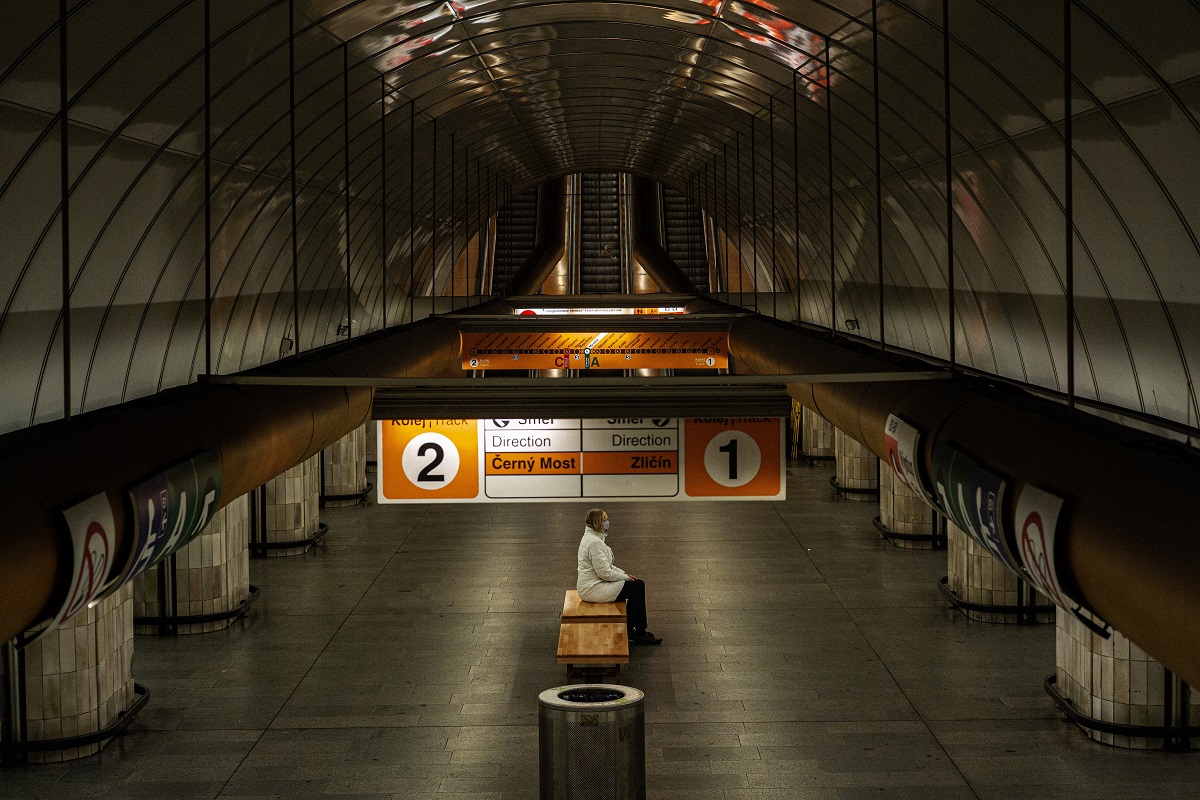Still unexplained
The hunt for the origins of Covid-19 has for the past four years been a tangled web of politics, power struggles, and international finger-pointing.
The Harvard study comes even as the US reported a record 2,228 deaths in the last 24 hours. On Friday, America’s daily deaths exceeded 2,000 for the first time with 2,069 people dying in 24 hours. The country is at the peak of its COVID-19 caseload and is looking out to implement eventual easing of tough lockdown measures.

A woman wearing a face mask sits on a bench at an empty metro station on April 15, 2020 in Prague amid restrictions due to the new coronavirus pandemic. (Photo by Michal Cizek / AFP)
Amid the worldwide lockdown to curtail the spread of COVID-19, Harvard scientists who modeled the pandemic, said on Tuesday that the novel coronavirus can’t be arrested by one time lockdown and repeated periods of social distancing may be required until 2022 to prevent hospitals from being overwhelmed.
The Harvard study comes even as the US reported a record 2,228 deaths in the last 24 hours. On Friday, America’s daily deaths exceeded 2,000 for the first time with 2,069 people dying in 24 hours. The country is at the peak of its COVID-19 caseload and is looking out to implement eventual easing of tough lockdown measures.
According to the Harvard team’s computer simulation, COVID-19 will become seasonal, like closely related coronaviruses that cause the common cold, with higher transmission rates in winter season. The study was published in the journal Science.
Advertisement
“But much remains unknown, including the level of immunity acquired by previous infection and how long it lasts,” the researchers said.
“We found that one-time social distancing measures are likely to be insufficient to maintain the incidence of SARS-CoV-2 within the limits of critical care capacity in the United States,” lead author Stephen Kissler said while talking to reporters.
“What seems to be necessary in the absence of other sorts of treatments are intermittent social distancing periods,” he added.
“Widespread viral testing would be required in order to determine when the thresholds to re-trigger distancing are crossed,” said the authors.
The relaxation in the lockdowns can be considered when the treatments and vaccines become available. But until then, on and off distancing would give hospitals time to increase critical care capacity to cater for the surge in cases that would occur when the measures are relaxed.
“By permitting periods of transmission that reach higher prevalence than otherwise would be possible, they allow an accelerated acquisition of herd immunity,” said co-author Marc Lipsitch.
Conversely, too much social distancing without respite can be a bad thing. Under one modeled scenario “the social distancing was so effective that virtually no population immunity is built,” the paper said, hence the need for an intermittent approach.
The authors acknowledged a major drawback in their model is how little we currently know about how strong a previously infected person’s immunity is and how long it lasts.
Based on closely-related coronaviruses, the researchers made best guesses that COVID-19 will confer some immunity, for up to about a year. There might also be some cross-protective immunity against the novel virus if a person is infected by a common cold-causing betacoronavirus.
However, they can say with most certainty that the virus is here to stay. The team said it was highly unlikely that immunity will be strong enough and last long enough that COVID-19 will die out after an initial wave, as was the case with the SARS outbreak of 2002-2003.
Antibody tests that have just entered the market and look for whether a person has been previously infected will be crucial in answering these vital questions about immunity, they argued, and a vaccine remains the ultimate weapon.
The research paper has gathered a lot of praise by many experts, even as they emphasized how much remained unknown.
“This is an excellent study that uses mathematical models to explore the dynamics of COVID-19 over a period of several years, in contrast to previously published studies that have focused on the coming weeks or months,” Mark Woolhouse, an infectious disease epidemiologist at the University of Edinburgh said.
“It is important to recognize that it is a model; it is consistent with current data but is nonetheless based on a series of assumptions — for example about acquired immunity — that are yet to be confirmed.”
(With AFP inputs)
Advertisement